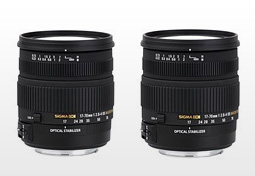Sigma 17-70 OS HSM DxOMark brief review and comparisons
Sigma 17-70 OS HSM Nikon mount
On the DxOMark scores this lens ranks:
- 9, when used at 17mm f/2.8 mounted on a Nikon D300,
- 11, when used at 17mm f/2.8 mounted on a Nikon D7000.
To see the data in detail see the performance of the Sigma 17-70 OS HSM on a Nikon D300, and on a Nikon D7000
What to know
With these measures in mind, we can say that even at its maximum level of quality, obtained at 17 mm f/2.8 this score remains pretty low.
Looking further though, the DxOMark score map indicates a pretty good homogeneity on the whole focal range, nevertheless, the score is perhaps a bit too low as well.
What we like
Both the vignetting and chromatic aberration are pretty well controlled on the whole focal range even on its widest aperture.
What could be better
Unfortunately the resolution is not homogenous in the field, even if this lens provides a good sharpness at the center, the resolution decreases very rapidly in the field.
Sigma 17-70 OS HSM Canon mount
See results for this lens when mounted on a Canon EOS 7D
This lens scores pretty close to its Nikon mount version and all the remarks to be made are along the same lines, except for resolution: the Canon version is a bit higher when mounted on a Canon EOS 7D than the Nikon version when mounted on a Nikon D7000.
You can find the full comparison here :
Sigma 17-70mm F2.8-4 DC Macro OS HSM Canon mounted on a Canon EOS 7D vs. Sigma 17-70mm F2.8-4 DC Macro OS HSM Nikon mounted on a Nikon D7000.
How is the Sigma 17-70 OS HSM compared to its previous version?
We have a series of comparisons of this lens (Canon and Nikon) versus its previous version with the same mounts.
- For the Nikon mount: Sigma 17-70mm F2.8-4.5 DC Macro HSM vs Sigma 17-70mm F2.8-4 DC Macro OS HSM, both mounted on a Nikon D300s
- For the Canon mount: Sigma 17-70mm F2.8-4.5 DC Macro HSM Canon vs Sigma 17-70mm F2.8-4 DC Macro OS HSM Canon mounted on a Canon EOS 500D
Comparing the 24-70mm f/2.8 by Nikon vs the 24-70mm f/2.8 by Sigma (Nikon mount) both mounted on a Nikon D3x
There is almost no competition on this one, see the full comparison here.
The Nikon 24-70mm takes clearly the lead on the DxOMark Score:
- Nikon: 28
- Sigma: 21
The Nikon 24-70mm f/2.8 achieves better scores on the whole focal and aperture ranges.
Resolution
61 lp.mm for Nikon and 57 lp.mm for Sigma, in the center, the Sigma lens achieves pretty good results but the Nikon lens stays ahead.
The gap becomes wider when we look at the results in the fields: homogeneity is clearly better on the Nikon side; unfortunately it is precisely at this where the Sigma lens finds its main weakness.
Vignetting and chromatic aberration
On the Sigma, vignetting is very high at 24mm f/2.8 and 70mm f/2.8 (more than 2 EV).
On the Nikon 24-70mm, vignetting is strong on the whole focal range for f/2.8.
Chromatic aberration is very high for these two models
Comparing the 24-70mm f/2.8 by Canon vs the 24-70mm f/2.8 by Sigma (Canon mount) both mounted on a Nikon Canon EOS 1Ds Mark III
Here, the competition gets quite interesting, see the full comparison here.
These two lenses have a very close DxOMark Score:
- Canon: 21
- Sigma: 22
Looking at the DxOMark score map, the two lenses provide similar results on the whole focal range.
The Canon 70mm focal seems a little bit better than the Sigma one, on the other hand at the f/8 aperture we get better results on the whole focal range with the Sigma lens; these are the only noticeable differences.
Resolution
These 2 lenses perform pretty well on the Canon EOS 1Ds Mark III.
It’s worth noting that the resolution decreases slightly on the Sigma lens at 50mm f/2.8 and 70mm f/2.8. On the Canon 24-70mm, resolution remains pretty high on the whole focal range from f/2.8 to f/11.
In the field, we can make the same remark we made about the Sigma 24-70mm Nikon mount: it decreases too much and too rapidly, especially at f/2.8.
The same remarks about vignetting and chromatic aberration can be applied to the Sigma with Nikon and Canon mounts.
Here are other interesting comparisons:





DXOMARK encourages its readers to share comments on the articles. To read or post comments, Disqus cookies are required. Change your Cookies Preferences and read more about our Comment Policy.